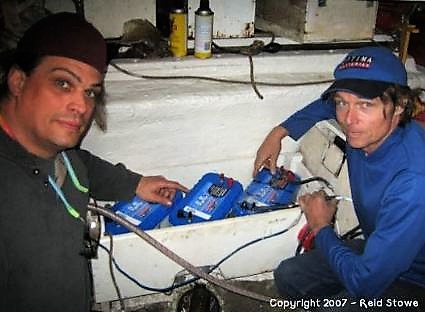What Preppers can learn from Reid Stowe

- Sponsor
- OPTIMA Batteries
- Location
- New York, NY


While waiting for the Packer game to start last weekend, we decided to watch some on-demand shows, including National Geographic's Doomsday Preppers program. One of the individuals profiled in that program was Bryan May, who coincidentally, runs a car audio business.
In Bryan's feature, viewers see his row of 40 car batteries, that he uses as a reserve power source, maintained by both solar and wind power from the roof of his house. Right away we were concerned that Bryan had so many lead-acid batteries in an enclosed area in his home, with no apparent provisions for proper ventilation.
Even "sealed" lead-acid batteries can vent gas in extreme situations and when that happens, the gas is both flammable and toxic- not a good combination for your fallout shelter. We always recommend mounting our batteries in well-ventilated areas or if they are mounted in enclosed spaces, to seal them in a battery box that is vented to the outside air.
Later, we watched another feature where prepper Johnny O. shared the redundancies he has built into his contingency plans for TEOTWAKI (The End Of The World As We Know It). Johnny basically had three of everything, including escape routes. That got us thinking about Bryan's battery configuration again. What if his solar panels or wind turbine malfunctioned and overcharged his batteries?
If all of Bryan's batteries were wired together, they are all vulnerable to being damaged at the same time. Any batteries wired in series or parallel should also be identical in age, size and type. That made us think of one of our sponsored sailors, Reid Stowe, who made a world record-setting voyage that kept him at sea for 1,152 consecutive days.
Stowe spent over three consecutive years at sea and nine OPTIMA BLUETOP batteries kept him plugged in the entire time. (We wonder how he would score on Doomsday Preppers?) As is evident in this photo, Reid split his BLUETOPs into three banks of three (remember Johnny O's redundancies?). While Bryan could always remove batteries from his bank, should they stop functioning, that doesn't help him avoid a potentially catastrophic incident with all of them.
Our engineers also recommend periodically rotating batteries in banks of three or more within the bank, as one would with a set of tires on their car. That way, Battery "A" isn't always the closest to the charger and Battery "C" isn't always the furthest.
There are a lot of folks online giving theoretical advice these days about how to prepare for an emergency scenario, when access to food, fresh water, shelter and electricity could become compromised. Very few have ever actually lived in such an environment for more than a few weeks at a time. Reid Stowe lived it for several years and while not all of his experiences at sea may necessarily translate to life on land, many can likely learn at least a few things from the preparations he made prior to his voyage.
If you'd like to find out more about Reid's journey, you can read his 1,000 Days at Sea blog here. If your bugout plan involves heading out to sea, you'll definitely want to read up on Reid's adventure.
